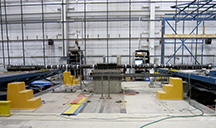Earthquake engineering conference to highlight remotely installed pipe liners for earthquake-resistant pipelines
July 15, 2014
 |
|
Pipeline specimens were anchored to both shake tables to simulate the passage of a seismic wave through two adjacent push-on joints. Experiments took place at the NEES at University at Buffalo Laboratory. (Photo: George E. Brown, Jr. Network for Earthquake Engineering). |
BUFFALO, New York - Earthquake-engineering researchers are meeting this month to discuss methods for improving the nation’s seismic safety, including the security of critical underground lifelines such as water and wastewater pipelines.
In particular, recent experiments have validated the excellent seismic performance of "cured-in-place pipelining" (CIPP) - flexible tubular membranes saturated with thermosetting resin - that can be used to retrofit existing pipes. The earthquake-resistant pipeliner can be installed remotely without digging up existing lines and could be used to prevent earthquake damage to the seismically vulnerable cast iron pipelines in the United States, many of which are 50-100 years old.
The technique involves the remote installation of fiber-reinforced polymer (FRP) linings inside existing, underground pipelines through trenchless construction procedures.
"Currently, in situ linings are not used for earthquake protection, and the lack of experimental validation and analytical procedures for evaluating the seismic response of pipelines retrofitted with FRP technology has been a serious barrier to the adoption of in situ linings for improved earthquake performance," said André Filiatrault, Professor in the Department of Civil, Structural and Environmental Engineering at the State University of New York at Buffalo.
Team members include University at Buffalo graduate research assistants Zilan Zhong and Amjad Aref; Cornell University professors Thomas O’Rourke and Harry Stewart; and Cornell graduate researchers Dimitra Bouziou and Brad Wham.
These new findings are included in a paper being presented during Quake Summit 2014, the annual meeting for the National Science Foundation's George E. Brown Jr. Network for Earthquake Engineering Simulation, a shared network of laboratories based at Purdue University. This year's summit is part of the 10th U.S. National Conference on Earthquake Engineering on July 21-25 in Anchorage, Alaska.
"The primary objective of our tests was to characterize the dynamic behavior and failure mechanics of cracks and weak joints in ductile iron pipelines with FRP linings. A secondary objective was to verify and quantify how the FRP liner could affect the seismic performance of pipe joints," Filiatrault said.
"We were pleased to confirm that earthquake response and rehabilitation of critical lifelines can be enhanced substantially by in situ pipe lining technologies," he said.
Results from the physical testing and analytical modeling show that the CIPP-retrofitted pipelines are able to accommodate very high levels of transient ground motion and moderate levels of permanent ground deformation, which provide substantial seismic strengthening in addition to efficient rehabilitation of aging underground infrastructure.
"The most important obstacle to the seismic upgrade of existing pipelines is the disruption of business and traffic caused by excavation of the pipelines," said O’Rourke, the project's principal investigator. "Using no-dig technologies and FRP liners allows for retrofitting pipelines in place without the substantial business and traffic interruptions and safety concerns related to conventional excavation with repair or replacement."
The full-scale dynamic testing of underground lifeline systems was conducted in the Structural Engineering and Earthquake Simulation Laboratory at the University at Buffalo, which hosts two high-performance, six-degrees-of-freedom shake tables. Pipeline specimens were anchored to both shake tables to simulate the passage of a seismic wave through two adjacent push-on joints. Full-scale tests of the CIPP-retrofitted pipeline response to abrupt ground displacement and fault movement were performed at the Cornell Large-Scale Lifeline Test Facility.
To measure and record the data from the dynamic experiments, the pipeline specimens and shake tables were equipped with an array of 103 sensors. Most of the instrumentation was concentrated in the vicinity of the two push-on joints of the pipeline specimens.
The team partnered with Insituform Technologies, Inc. and Progressive Pipeline Management, LLC, who lined the experimental pipe specimens, and with the Los Angeles Department of Water and Power, who donated the ductile iron pipe used for test specimens, and with the California State University at Los Angeles.
The Quake Summit conference presentation entitled Performance of Water Pipelines Retrofitted with Cured in Place Pipe Liner Technology under Transient Earthquake Motions, is slated for Wednesday, July 23, from 5-7 p.m. The presenter is Zilan Zhong, PhD candidate from the University at Buffalo.
Writer: Marti LaChance, 765-496-3014, lachance@purdue.edu
Sources: André Filiatraut, af36@buffalo.edu
Note to Journalists: Electronic copies of the research paper are available by contacting Marti LaChance, 765-496-3014, lachance@purdue.edu
ABSTRACT
Abstract: Seismic Testing of Critical Lifelines Rehabilitated with Cured in Place Pipeline Lining Technology
Zilan Zhong1, Dimitra Bouzioub2, Brad Wham2, Andre Filiatrault1, Amjad Aref1, Thomas D. O’Rourke2 & Harry E. Stewart2
1 Department of Civil, Structural and Environmental Engineering, State University of New York at Buffalo, Buffalo, New York; 2 School of Civil and Environmental Engineering, Cornell University, Ithaca, New York
Trenchless technology is well accepted for repairing critical underground lifelines with minimal ground surface disruption. The cured in place pipeline (CIPP) lining process is an application of trenchless technology that involves the installation of fiber reinforced composites inside existing pipelines. The uncertain performance of pipelines reinforced with CIPP linings in seismic areas is a barrier to the adoption of this method for seismic retrofit. This article evaluates experimentally the transient seismic response of pressurized pipelines reinforced with fiber reinforced polymer (FRP) linings. The test results show that reinforced pipelines can accommodate very high intensity ground motions and can provide substantial seismic strengthening in addition to efficient rehabilitation of aging underground infrastructure.

